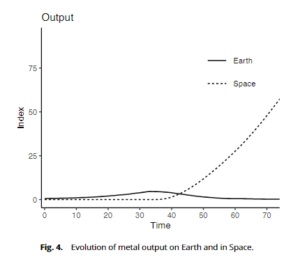“The exploration and use of outer space, including the Moon and other celestial bodies, shall be carried out for the benefit and in the interests of all countries, irrespective of their degree of economic or scientific development, and shall be the province of all mankind.”
Article I, Outer Space Treaty
The OST (Outer Space Treaty), signed in 1967 between the two super-giants, namely the USA, and the USSR (now Russia) was the pivotal point for future space exploration of celestial bodies to discover rare earth minerals, isotopes, and natural resources. Currently, over 100 countries have signed the treaty, including the UK, China, France, and India.
Other treaties have been formed on the foundations laid by the OST. The Rescue Agreement, for example, explains the state’s obligations to help astronauts in distress. Likewise, the Registration Convention requires countries to provide a roster of objects launched into outer space. Every pact was analyzed and agreed upon by most nations, leading to the execution of space-exploration programs in the 20th century.
Space Exploration – A Brief Prologue
From the famous Apollo missions to the recent Mars exploration by robots, the limitless and expansive space depicts promising results for Earthlings. Space exploration, as it is, commenced in the late 1960s when the NASA mission (Apollo 11) carried 193gms of rock-soil sample from the Moon’s surface.
The landmark exploration was soon followed by the Apollo 12 and Luna 16 missions, which garnered approx. 682 gms of lunar regolith (combined) back to Earth.
During the 1970s and 80s, the planets in the Solar System were visited by different spacecraft: Venera 7 made a successful trip to Venus, Mars 3 spacecraft made a soft landing on the Red Planet, and Pioneer 10 and 11 flew by Jupiter and Saturn respectively.
The 90s saw the launch of the famous Hubble Space Telescope, which has made more than one million observations to-date. Traveling at a speed of 17,500 mph, it has discovered black holes and moons of Pluto (Nix and Hydra). It also created a 3D map of dark matter. Space travel continued with Galileo, the first machine to orbit Jupiter in 1995.
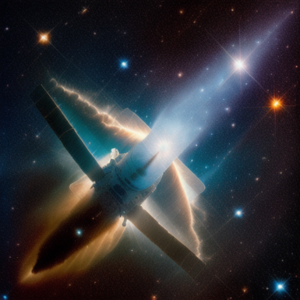
The Moon, Asteroids, and the Red Planet have been visited in search of resources, including water, oxygen, volatiles, minerals, etc. These searches were made possible by space engineers who designed advanced robots like Curiosity, Perseverance, and Sojourner to carry out missions in outer space. Additionally, there are 17 robots working in different capacities, providing useful information to humans.
What is Space Mining?
The exploration and excavation of natural resources to be found on different solid structures, such as Moon, Planets, Comets, and NEA’s (Near Earth Asteroids) is called space mining. According to Daniel Sox, the co-founder of Canadian Space Mining Corporation, “Space mining is definitely going to happen. It is an inevitability, is not a possibility and it’s going to happen in the very near-term”.
For years, scientists, govt. officials, and other groups are finding ways to manage extra-terrestrial mining. Key decisions revolve around the use of appropriate material, special equipment, financial resources, extraction of elements, and more. Moreover, detailed research and analysis have propounded essential elements that are available for extraction:
- Helium-3
- Platinum
- Osmium
- Palladium
- Taenite
- Schreibersite
- Rare-Earth Metals
- Other Phases of Matter
Why is Space Mining Essential?
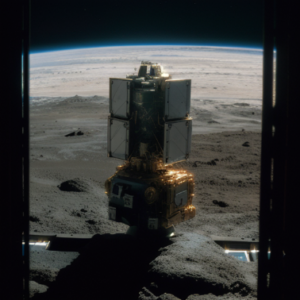
Space mining, in all respects, is an innovative approach towards the attainment of resources for better quality of life. Konstantin Tsiolkovsky, a Russian scientist, was the first one to propose the idea in the 19th century. Although it has not yet been proven that the process is commercially viable, work has commenced nonetheless: The OSIRIS-Rex space mission gathered a small sample from near-Earth asteroid, Bennu for study purposes.
Being in the tech era, demand for automated systems have increased at a rapid pace. Data engineers, scientists, and other stakeholders have joined hands to develop key resources for mankind: Amazon Alexa, Sophia, and human-less industries are some examples. However, these advancements have come with a price; the costly degradation of the Earth’s environment for rare minerals.
Metal excavation on Earth has lost its charm over the years. With high-quality grades fast depleting, global mining firms have no choice but to extract lower-grade deposits, which create more waste and carbon dioxide emissions in addition to rising water and energy requirements. To manage the concern, various studies, such as the Ramsey Growth Model, have been conducted. According to the theory, environmental and social costs will reduce, while the use of metals on Earth will continue in the future.
Is Space Mining Sustainable?
Did you know that spacecraft releases black carbon into the stratosphere which can cause harm to the ozone layer? Such processes, if managed regularly, can have a drastic impact on life. Scientists have, however, come up with better solutions, such as liquid-hydrogen based propellants. Together with fossil fuels, investments in hydrogen extracted from renewable energies are on a rise.
As foretold by Harvard International Review, asteroid mining will yield sizeable profits that will impact global economies with regards to new industries and employment opportunities. More so, technological innovations like 3D printing will be beneficial for space travelers in years to come.
But the question remains: Is space mining a sustainable choice?
- The untapped resources in space (16 Psyche, Davida, 4660 Nereus, etc.) are financial boosters for the space industry. Offering trillions and quintillions of dollars upon excavation, the potential is limitless, to say the least.
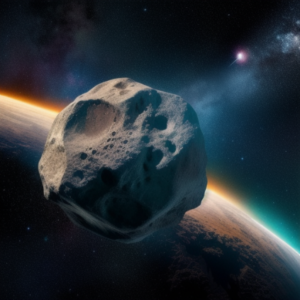
- NASA aims to send humans back to the Moon in the hope of sending astronauts to the Red Planet, using the resources present in/on the surface. Dr. Dmriti Atri, an astrophysicist in NYU, Abu Dhabi, said, “The Moon could potentially provide access to rare earth elements, indispensable for the production of smartphones and medical equipment….”
- The abundance of frozen ice on the Moon’s surface can ensure sustainable space operations. Astronauts can grow plants, extract oxygen, and use the elements for rocket fuel. Due to the Luna’s lower gravity, it will take less fuel to launch a spacecraft compared to the Green Planet. This will help in reducing costs and expenditures in the long run.
- Blue Origin, an American aerospace company, has converted simulant lunar regolith into solar cells to provide energy to space colonies. With this gadget, excess energy can be transferred to the habitable planet for economic benefits.
Graphical Representation
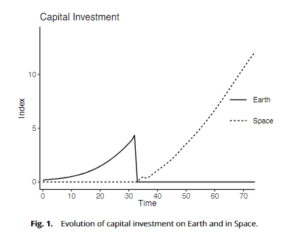
The above figure is a representation of investment in mining capital on Space and in Earth. After a period of 30, the investment converts to Space mining capital. The initial R&D was done to increase the productivity of space mining.
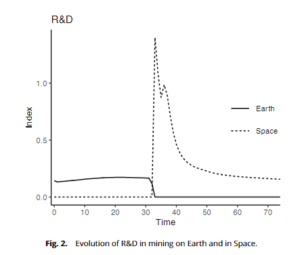
This graph depicts the change in research and development investment in metal production on Earth and in Space. Initially, R&D was managed on the Green Planet but it soon lost favor in comparison to Space metal mining, where opportunity for expansion is higher.
This figure shows the change of metal production on Earth and in Space. The production, initially starting on Earth, converts to Space mining because of declining capital investment, reducing stocks, and labor allocation.
The KISS Study
According to the Keck Institute of Space Studies (KISS), the cost to identify, extract, and send back a 500-ton asteroid to lower-orbit Earth was 2.6 billion USD, minus the cost of infrastructure (2012). The study states that an asteroid of 7m in diameter and 500,000 kg in weight can be managed by advanced technology in the next decade.
Achievements in Space Travel & Mining
With the hopes of building a space economy for the future, industry, space experts, and governments are infusing their expertise, knowledge, and capital with zest. Companies like Planetary Resources and Deep Space Industries have designed satellites that have identified around 15,000 asteroids with substantial possibility for mining.
JAXA
JAXA (Japanese state space agency) conducted a successful asteroid-sample-retrieval mission called Hayabusa in 2010. Upon reaching the Itokawa Asteroid, essential surface and topography data was collected and returned back to Australia. Soon after, the Hayabusa 2 mission was also launched in 2018. Samples were amassed from the near-Earth asteroid Ryugu, with the mission, making a return in two years’ time.
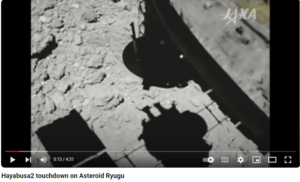
Video Link: https://www.youtube.com/watch?v=4xnInpqMiG4
MASCOT
Developed by the German Aerospace Center (DLR) and French Space Agency (CNES), the MASCOT Rover (Mobile Asteroid Surface Scout) landed on Asteroid Ryugu after some minutes of the Hayabusa 2 mission. Valuable data was collected by the machine, being in operation for 17 hours. One of its findings were related to the C-type asteroid’s porosity level, stating that the quantity of porous materials was higher than expected.
CHANDRA X-RAY OBSERVATORY
In the late 90s, NASA launched one of the most sensitive and advanced X-ray telescopes that could visualize split-second movements, such as particles disappearing in a black hole. The Chandra X-ray Observatory focuses on high-energy parts of the universe. Till now, it has provided clear images of quasars, supernova remnants, supermassive black holes, and exploding stars.
KEPLER SPACE TELESCOPE
The Kepler Space Telescope, created for search of exoplanets (planets similar to Earth), have discovered more than 2500 planets that are potentially habitable. It was launched into the Earth-trailing heliocentric orbit by NASA in 2009. Some of its major findings include:
- Kepler-22b
- Kepler-10b
- Kepler-62f
- Kepler-186f
- Kepler-1625b
- Others
Last by not the least, the first space tourist, named Dennis Tito, paid $20 million for his maiden trip to Space. He set off from Kazakhstan for an 8-day holiday for the ISS (International Space Station).
Space mining has been proclaimed as a multi-trillion-dollar industry, ready to be explored in the near future. Let’s hope for another giant leap for mankind!
Additional Video Links
Asteroid Mining: https://www.youtube.com/watch?v=erF17yO9VsE
Future of the Space Economy: https://www.youtube.com/watch?v=QHVAERH4yzc
Moon Mining & Asteroid Wealth: https://www.youtube.com/watch?v=KHcE1rsj51U
Human Achievements in Space Exploration: https://www.youtube.com/watch?v=TZRLYWr9QBo
Discovery of Exoplanets: https://www.youtube.com/watch?v=3ILVuU1gekc

